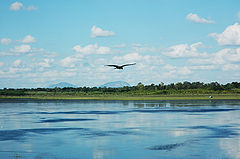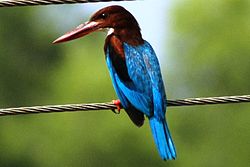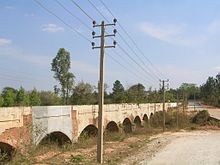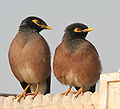- Hesaraghatta Lake
-
Hesaraghatta Lake 
View of Lake in 2006 Location Bangalore District, Karnataka Coordinates 13°09′N 77°29′E / 13.15°N 77.49°ECoordinates: 13°09′N 77°29′E / 13.15°N 77.49°E Lake type Freshwater lake Primary inflows Arkavathy River Catchment area 73.83 km2 (28.51 sq mi) Basin countries India Surface area 4.50 km2 (1,110 acres) Max. depth 27.44 m (90.0 ft) Water volume 28,240,000 m3 (997,000,000 cu ft) Surface elevation 861 m (2,825 ft) Settlements North-west of Bangalore Hesaraghatta Lake (Kannada: ಹೆಸರಘಟ್ಟ ಕೆರೆ) is a manmade reservoir located 18 km to the north-west of Bangalore in Karnataka state, India. It is a fresh water lake created in the year 1894 across the Arkavathy River to meet the drinking water needs of the city. Sir K. Seshadri Iyer, the then Dewan of erstwhile Mysore state and the then Chief Engineer of Mysore, M. C. Hutchins, planned to build the scheme called the “Chamarajendra Water Works” to store a three-years' water supply to the city.[1][2]
Contents
Access
The lake is approachable by road from Bangalore at a distance of 26.5 km to the north-west of the City .[3]
Topography
The total catchment area draining into the Lake at the dam built on the Arkavathy River is 73.84 km2 (2189 mi2), out of which the direct draining catchment is 2.68 km2 (6.86 sq mi2).There are 184 tanks built in the Arkavathy River basin upstream of the Hesaraghatta lake. The Arkavati River originates in the Nandi Hills of [chickballapurDistrict]] and joins the Kaveri River at Kanakapura after flowing through Kolar District and Bangalore Rural district...[4][5] The Vrishabhavati and the Suvarnamukhi are the tributaries which drain part of Bangalore and Anekal Taluk respectively into the Arkavati River. The catchment receives a mean annual rainfall of 859.6 mm.[6]
Hydrology and water works
The Arkavathy River is one of the two rivers which partially meet the water supply needs of Bangalore; the other being the Kaveri. The reservoirs created by building dams on the Arkavathy are the "Hesaraghatta" and the “Chamarajasagara” at Thippagondanahalli (TG halli) built during the years 1894 and 1933 respectively. The Hesaraghatta dam is an earthen bund of 1690 m (5544 ft) with a total height of 40.55 m (133 ft) creating the Hesaraghatta Lake (reservoir) with storage of 997 M.Cft at full reservoir level with a lake surface area of 450 ha (1,124 acres). Water from the reservoir is taken through initially a 1.4 m dia (42" dia) Hume pipe to the Soladevanahalli Pumping Station by gravity and then pumped (using steam pumps initially and later changed to electric pumps at Soledevanahalli) against a head of 115 to 135 m to the Combined Jewel Filters (CJF) plant at Malleswaram for treatment and supply to the consumers in the city.[3][7]
When the Hesaraghatta Lake started drying up in the year 1925, as an urgent remedial measure, another dam was built to create a reservoir called the Chamaraja Sagar at TG Halli, downstream of the Hesaraghatta Lake. This dam has been enlarged from time to time, over the years, to meet partially, the increasing water supply demand of Bangalore.[8]
Deterioration of the lake
The reservoir is reported to have filled up last in the year 1994 and thereafter the lake’s deterioration and drying up started, reducing its reliability as a water supply source.[9]
The reasons attributed to the lake’s drying up are erosion in the catchment and consequent capacity shrinking due to continuous silting. As of July 2009, the lake is completely dry. .[10]
Avifauna
Even in the deteriorated condition of the lake, birds such as the kingfisher (Halcyon smyrnensis), magpie robin (Copsychus saularis), little egrets, common mynas (Acridotheres tristis), Brahminy kites, black drangos, bulbuls, greater coucals, purple sunbirds, etc., (some are pictured in the gallery.) have been reported in and around the lake periphery. Documented records of sighting of 2000 water birds of 29 species have been reported. The lake is also a great place for the winter migrants. Harriers and Spotted Eagles have been reported from this lake during winter. Bird poaching traps, a common sight, are located and removed from the bed of the lake quite often.[11][12]
Call for restoration
Apart from the water supply, the lake, which was known for its birds and river rafting (wind surfing), has drawn the attention of public spirited organizations and individuals for undertaking restoration works to revive it.[10]
- The Madras Engineer Group (MEG) of the Indian Army in association with local community organizations such as the “Arkavathy Kere Ulisi Andolana Samithi (AKASH)” , which literally means "Save Arkavati lake Movement" of Hesaraghatta and ‘‘Friends of Hesaraghatta Lake’’ undertook ‘shramadan’ (voluntary manual labour), in May 2004, to clear the main inlet to the lake. It is reported that this activity enabled increase of water storage in the lake which was stated to be 1.22 – 1.83 m (4–6 feet) of water in an area of about 66.7 ha (150 acres). AKASH has now sought help of more volunteers to increase the depth of the lake to 3m (10 feet) to attract several species of birds.[10]
- The “OORU-NEERU” Water Walk was organised by the public spirited people of Bangalore to Hesaraghatta Lake to see and study the status of the Lake and evaluate the relationship of a city to its waters. The observation made by the study is that:
It is more correct to refer to the Hesserghatta reservoir as a ‘once upon a time’ water lifeline for Bangalore rather than a current lifeline.
The Walk has also brought out facts such as, a) presence of the reservoir and old pumps, b) the building of 1896 A.D vintage which has maps displayed in a building depicting how the water was received and pumped, c)the water level chart of the Hessarghatta reservoir till 2000 A.D, d)a rain gauge to measure the rainfall, e) the remnants of the brick aqueduct to convey water by gravity at Turbanahalli and f)the Siphon at the Hesaraghatta Lake used to discharge the flood waters when the reservoir was full. The final verdict of the Water Walkers is that[13]:
The Hessarghatta reservoir has the capacity to supplement Bangalore water requirements at a far cheaper cost than any other. It makes ecological and economic sense to look at its revival.
- Another voluntary effort, the latest, is of the three member team of a villager, a photo journalist and an economist who found that the lake was being de-silted with bull dozers at the lake's eastern channel to connect it with the catchment area and which could bring water into the lake during the monsoon.[14]
Places of interest
The fertile area which encircles the Lake has a number of important institutions such as the Government Aquarium, Horticultural Research Institute, Indo-Danish Poultry and Dairy farms with its livestock breeding and poultry centers which face the Lake, and the famous Nrityagram, the dance village — India's first modern Gurukul (residential school) founded by Odissi danseuse, the late Protima Gauri in 1990.[12]
Gallery
References
- ^ http://www.bwssb.org/water_source_schemes.html Water Supply and Source
- ^ http://www.bwssb.org/water_source_schemes_hessarghatta.htmlHesarghatta
- ^ a b http://www.geopassage.com/India/attraction/Bangalore/Hesarghatta.htm Hesarghatta
- ^ http://www.bwssb.org/help_faq.html Board of Water supply Bangalore
- ^ http://www.bwssb.org/water_source_schemes_hessarghatta_lake_detail.html Hesarghatta lake details
- ^ http://parisaramahiti.kar.nic.in/blore.html Envis Centre, Bangalore
- ^ http://www.bwssb.org/water_source_schemes_hessarghatta.html Board of water supply bangalore
- ^ http://www.bwssb.org/water_source_schemes.html Water supply and source
- ^ http://www.hindu.com/pp/2...Excerpts from Lessons from a reservoir by S. Vishwanath
- ^ a b c http://bangalorebuzz.blogspot.com/2004/12/army-akash-revive-hesarghatta-lake.html
- ^ http://howyoudoin.wordpress.com/2008/02/24/my-first-birding-trip-hesaraghatta-lake/. My first birding trip – Hesarghatta
- ^ a b http://wgbis.ces.iisc.ernet.in/energy/lake2006/programme/programme/lake2006_Pdf/Harish%20Bhat_Tanks%20of%20North%20Bangalore.pdf Diversity at the Tanks of North BangaloreWater Bird Diversity at the Tanks of North Bangalore
- ^ http://bcp.wikidot.com/city-walks:water-walk Bangalore City project, Ooru Neeru : water walk
- ^ http://www.telegraphindia.com/1050227/asp/look/story_4425716.asp Saving Hesaraghatta, the saga of two rajas, one bhatta and a lake
Hydrology of South Asia Inland Indus · Ganges · Yamuna · Chenab · Jhelum · Bhagirathi River · Brahmaputra · Godavari · Narmada · Tapti · Ravi · Beas · Sutlej · Padma · Sarasvati · Sharda · Krishna · Kaveri · Kali River · Meghna · Gandaki River · Mahanadi · Mahaweli · Son · Ghaghara · Betwa · Chambal · Kosi · Sankosh · Ganges Basin · Ganges Delta · Indus Delta · Dal Lake · Pookode Lake · Skeleton Lake · Chilka Lake · Lake Powai · Borith Lake · Saiful Muluk · Gosaikunda · Nizam Sagar · Red Hills Lake · Malampuzha · Kerala Backwaters · Damodar · LuniCoastal Categories Lakes of India / Nepal / Pakistan · Reservoirs and dams in India · Rivers of Bangladesh / Bhutan / India / Nepal / PakistanCategories:- Lakes of Karnataka
- Tourism in Karnataka
- Lakes of Bangalore
Wikimedia Foundation. 2010.










